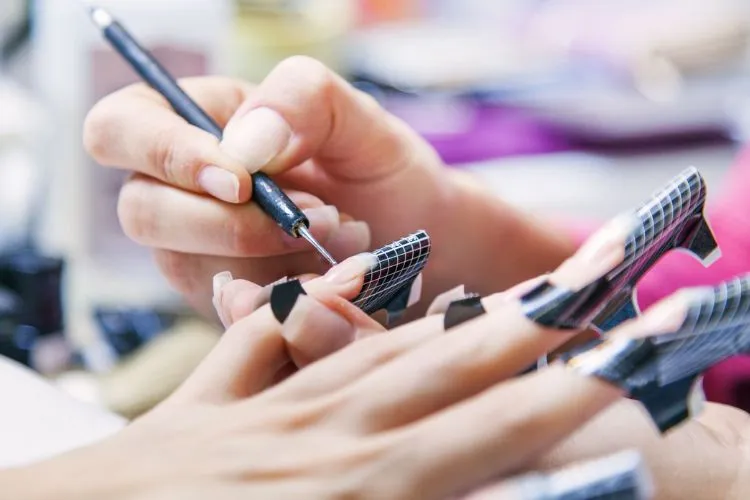Acrylic nails have become a staple in the beauty industry. Admired for their durability and the seamless way they enhance the look of natural nails, it’s no wonder many opt for this popular nail enhancement.
However, acrylic nail wearers often face the issue of their nails lifting. So, why do acrylic nails lift? Understanding the causes can help extend the life and beauty of acrylic nails.

What Are Acrylic Nails?
Acrylic nails are a form of nail extension that’s popular worldwide. They’re created by mixing a liquid monomer with a powder polymer to form a hard protective layer over the natural nail.
This mixture begins to harden upon exposure to air, creating the acrylic nail. The beauty of acrylic lies in its versatility in shape, length, and color.
The Science Behind Acrylics
When the monomer and polymer mix, they undergo a chemical reaction. This process, known as polymerization, causes the mixture to harden and bond to the surface of the natural nail.
The strength of this bond is crucial to how well the acrylic nails will wear and how prone they are to lifting.
Why Do Acrylic Nails Lift?
Pre-Application Factors
Natural Nail Preparation: The foundation of a lasting acrylic nail application lies in the preparation of the natural nail. It’s critical to start with a clean, dry and buffed nail surface.
Prepping includes removing any traces of oil or existing nail polish and gently buffing the nail to create a surface that the acrylic can easily bond to. If the nail isn’t properly prepared, the risk of lifting increases.
Application Environment: The conditions under which acrylics are applied play a vital role. Ideally, the application should occur in a controlled environment where temperature and humidity do not interfere with the setting process of the acrylic.
Application Technique
Proper Application: A precise ratio of liquid to powder is essential for creating the right consistency when applying acrylics. Too much liquid can make the mixture too runny and prevent proper bonding, while too much powder can make it too thick and lead to a less flexible and more prone to lifting overlay.
Additionally, careful application around the cuticle area is vital, as acrylic should never touch the skin to avoid lifting.
Adhesion Issues: The adherence of acrylic to the natural nail must be seamless. If the technician is not applying the mixture correctly, it can lead to areas where the acrylic hasn’t bonded correctly, leading to pockets that can cause lifting.
Incorrect Nail Size and Shape: Fitting the acrylic to the nail’s natural shape is essential. Ill-fitting acrylics can have gaps at the edges, leading to lifting. Acrylic nails should mimic the natural nail shape for a perfect fit.
Aftercare and Maintenance
Proper aftercare is crucial to prevent lifting. Exposure to harsh chemicals, water, and physical stress can weaken the bond between the acrylic and the natural nail, causing it to lift.
It’s crucial to wear gloves when cleaning or using chemicals and to avoid using the acrylic nails as tools to prevent unnecessary pressure.
You may also find useful: How Long Do Acrylic Nails Last? | Hard Gel Nails vs Acrylic Nails
The Role of Nail Technician Expertise
The skill and experience of a nail technician are paramount. An experienced technician can properly prepare the natural nail, apply the acrylic accurately, and advise on aftercare.
Routine maintenance such as fills, also known as “in-fills”, are necessary approximately every two weeks to correct any lifting and prevent further damage.

How to Recognize Lifting in Acrylic Nails
Lifting appears as a slight separation or gap between the acrylic and the natural nail, usually at the edges or near the cuticle.
It is important to address lifting as soon as it’s noticed to avoid moisture getting under the acrylic, which can cause nail infections or damage.
Preventing Acrylic Nails from Lifting
Using high-quality products is the first step in ensuring longevity in acrylic nails. Regular maintenance and promptly addressing any signs of lifting will go a long way in preserving the acrylic nails.
Proper aftercare, including using appropriate products recommended by the technician, is essential in preventing lifting.
Fixing Lifted Acrylic Nails
While temporary fixes may be tempting, they are not a substitute for professional repair. If you can’t visit a technician immediately, take extra care to prevent moisture and dirt from getting into any gaps.
However, for a long-lasting solution, it’s always recommended to have lifting treated by a professional.

Acrylic nails, when done correctly, can be a beautiful and long-lasting nail enhancement. Knowledge about why nails may lift and how to prevent it is key to maintaining the integrity and appearance of acrylic nails.
With the right care, acrylics can be a stunning addition to your beauty regime.
Frequently Asked Questions (FAQs)
How often should acrylic nails be filled to prevent lifting?
It is generally recommended every two weeks.
Can I fix lifted acrylic nails at home, or do I need to see a technician?
While minor issues can sometimes be temporarily addressed at home, a technician should handle any major lifting.
Is it safe to use glue to fix a lifted acrylic nail?
Using glue is not recommended as it can trap moisture and lead to fungal infections.
How can I tell if my acrylic nails are lifting due to an allergic reaction?
If there’s redness, swelling, or itching, an allergic reaction may be the cause.
Do certain daily activities increase the risk of acrylic nail lifting?
Yes, activities that involve heavy use of the hands or prolonged exposure to water can increase lifting risk.
Are there specific aftercare products that help prevent acrylic nail lifting?
Quality cuticle oil and hand creams recommended by your technician can help maintain nail health and adhesion.
Conclusion:
In conclusion, acrylic nails lift due to a variety of factors ranging from pre-application preparation, the application technique, to aftercare and maintenance practices.
Understanding these reasons is key to prolonging the durability and beauty of acrylic nails. Ensuring natural nails are properly prepped, choosing an experienced technician, and following thorough aftercare routines can significantly minimize the risk of lifting.
Ultimately, the longevity of acrylic nails lies in the delicate balance of professional application and diligent personal care, ensuring these enhancements remain as stunning as intended.

Meet Isabella Anderson, your acrylic painting mentor with over a decade of brush-wielding mastery. Dive into the colorful world of acrylics with her expert guidance, featured exclusively on ‘Acrylic Authority.’ Unleash your inner artist and explore the limitless possibilities of this versatile medium alongside a true acrylic aficionado.
